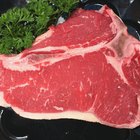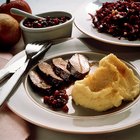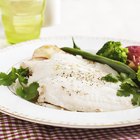Socha/iStock/GettyImages
For the most tender meat with the best flavor, choose goat steaks that come from young goats, which are also sometimes called capra, chevon or cabrito. Young goat has a similar flavor and texture to venison or lamb, and it pairs well with a variety of seasonings. One of the easiest techniques is to use a dry heat method such as grilling or broiling, although you can also pan-fry the steaks if you prefer a steak with a crispy, browned exterior.
Grilling or Broiling
Rub each goat steak with a drizzle of cooking oil and the spices of your choosing, or with your favorite marinade and place them in a bowl, baking dish or a resealable plastic bag. Marinate the goat steaks in the refrigerator overnight, or a minimum of 1 1/2 hours.
Prepare your charcoal grill by burning hardwood charcoal until it forms gray ash. Then arrange a large pile of coals on one side, to make a high heat, while arranging a thin layer on the other side for lower heat. If you have a gas grill, turn it on to medium-high to preheat. Alternatively, if you’re broiling your goat steaks, position the oven's rack so that the steaks will be at least 4 inches from the element.
Remove the steaks from the marinade, and transfer them to the grill or a broiling pan. If you're using a charcoal grill, place them on the high-heat section for about 1 minute per side to sear the steaks before moving them to the low-heat section. As a general rule of thumb, whether you’re grilling or broiling them, the steaks need about 5 to 6 minutes of cooking time for every inch of thickness. Turn the steaks with tongs when they're halfway done.
Check the steaks for doneness with a meat thermometer, removing the steaks once they reach temperatures of at least 145 degrees Fahrenheit. Let the steaks rest for at least 3 minutes before serving them.
Pan-Frying
Place a large cast-iron or heavy nonstick skillet on the stove, and turn the heat on to medium-high to preheat the pan.
Pat the steaks with a paper towel to remove any extra moisture from the surface of the meat. Then, season each side of the steaks with salt and pepper and any other seasonings you like.
Add enough oil to the pan to coat the bottom. Once the oil is hot enough to shimmer, add your goat steaks, leaving a little room between steaks.
Turn the steaks after 2 to 3 minutes of cooking, using tongs to flip the meat. Continue cooking the steaks for another 2 to 3 minutes, or until a meat thermometer reads at least 145 degrees Fahrenheit.
Related Articles

How to Cook Beef Tenderloin on a ...

How to Cook Antelope

How to Cook Venison Steaks With Onions

How to Make Perfect Lollipop Lamb Chops

How to Pan Cook Shark

How to Cook a Petite Filet of Beef in ...

How to Cook a Rib Eye to Medium-Well in ...

How to Cook Tender Rolled Flank Steaks ...

How to Cook a Filet Steak in the Oven ...

How to Cook Deer Steaks in the Oven on ...

Ways to Cook T-Bones Indoors

How to Broil Filet Mignon Wrapped in ...

How to Cook London Broil
How to Cook Boneless Top Chuck Steak in ...

How to Cook Spoon Steak

How to Cook Swai With Breading

How to Make a Venison Rub

How to Cook Sculpin Fish

How to Cook Venison Inside Loin

How to Cook an 8- to 10-Pound Beef ...
References
- Fire It Up; Andrew Schloss and David Joachim
- The Whole Goat Handbook; Janet Hurst
- The Illustrated Cook's Book of Ingredients; DK Publishing
- The Tex-Mex Grill and Backyard Barbacoa Cookbook; Robb Walsh
- The Splendid Table: Grilled Goat Chops with Garlic, Oregano and Lemon
- The Food Lovers Kitchen: Grilled Goat Chops with Winter Savory and Garlic
- USDA Food Safety and Inspection Service: Goat from Farm to Table
Tips
- Although many people enjoy the robust flavor of goat meat, if you're new to it or prefer a milder flavor, you do have options. Soak the steaks overnight in buttermilk or salt water to lessen the meat's gamey flavor. Another way to offset the flavor is to use bold accompanying flavors such as garlic, peppers and onions. Other flavors that pair well with goat meat include soy sauce, vinegar, curry powder, jerk seasoning, mint, yogurt, oranges and peanuts.
Writer Bio
Caryn Anderson combines extensive behind-the-scenes writing experience with her passion for all things food, fashion, garden and travel. Bitten by the travel bug at the age of 15 after a trip to Europe, Anderson fostered her love of style and fashion while living in New York City and earning her degree at New York University.